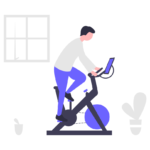Heart Rate Zones Calculator
| Zone | Description | Heart Rate Range |
|---|---|---|
| 1 | Recovery | |
| 2 | Aerobic | |
| 3 | Tempo | |
| 4 | Threshold | |
| 5 | Anaerobic |
Maximize Your Training with a Heart Rate Zones Calculator
Using a heart rate zones calculator is essential for optimizing your workouts and maximizing the benefits of your training sessions. By understanding your personalized heart rate zones, you can tailor your exercise routine to target specific fitness goals, such as weight loss, endurance, or cardiovascular health. A heart rate zones calculator helps you exercise smarter, not harder, ensuring you get the most out of your workouts while reducing the risk of overtraining or injury.
What is my LTHR and what does it stand for?
LTHR stands for Lactate Threshold Heart Rate. Similar to FTP being the maximal power you can output for one hour, LTHR would be your average heart rate over a one hour all out effort. Your average heart rate over a 20 or 30 minute all out effort is also acceptable for getting your LTHR. Although, it will usually give you a slightly lower number. This is because heart rate takes some time to creep up and stabilize, even with big efforts.
Why use LTHR vs Max Heart Rate?
A simpler, (usually) less accurate way to calculate your heart rate zones is to get them by using a percentage of your max heart rate. It’s somewhat similar to using your 1-2 minute power to get your FTP, it won’t be as accurate as a true FTP test. Maximum heart rate also has more variance from day to day.
How do I find my Max Heart Rate?
A good method to figuring out your max heart rate is to do a long warmup with a couple of relatively short efforts that elevate your heart rate. Don’t tire yourself out, but definitely get to the point where you are sweating and have elevated your heart rate to at least LTHR level for a short time. At the end, recover and then do an all out 2 minute effort. You should push yourself to absolute exhaustion.
Heart Rate Zones and how they relate to your training
- Zone 1 (Active Recovery) – You should be able to talk and breathe without any difficulty. Almost like sitting on the couch.
- Zone 2 (Endurance) – Talking and breathing should still be easy. Effort is noticeable but could (usually theoretically) be maintained for hours. Little to no concentration needed to maintain effort.
- Zone 3 (Tempo) – If you didn’t sweat much or at all in zone 2, you will start to here. Breathing is still relatively easy, concentration to maintain effort is required. Pace should still feel like it could be maintained for long durations.
- Zone 4 (Lactate Threshold) – Your cardiovascular system will begin to get challenged here. Breathing can go from manageable to labored depending on the duration.
- Zone 5 (VO2 Max) – Labored breathing, and talking is limited (and costly). Concentration needed for effort is high.
- Zone 6 (Anaerobic Capacity – All out 30 second to 2 minute bursts. Heart rate will be the least of your concerns. Breathing will be labored, intense and usually gasping for air if effort is long enough.
- Zone 7 (Neuromuscular) – All out bursts, heart rate is not a concern with these.
Training by Heart Rate
Using the heart rate zones calculator above, you can use traditional training methods by using cycling workouts dictated by heart rate. You can also adapt training plans tailored to power, and perform them with heart rate zones instead. A good place to start is to set aside 2 days a week where you go hard (threshold or VO2 max workouts), and do easy endurance for your other rides.
